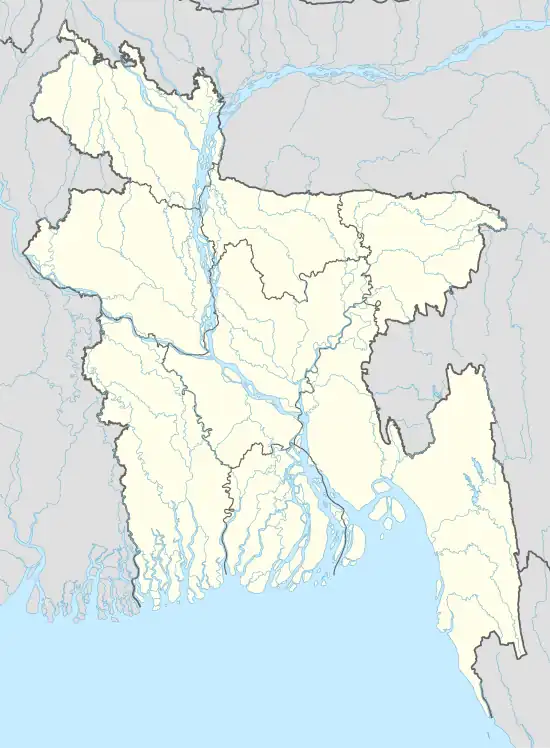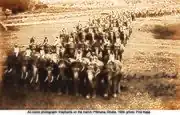Pilkhana
BGB Headquarters | |
|---|---|
Para-Military Cantonment | |
 Pilkhana Location in Bangladesh | |
| Coordinates: 23°43′57″N 90°22′30″E / 23.73250°N 90.37500°E | |
| Country | |
| Division | Dhaka Division |
| District | Dhaka District |
| Time zone | UTC+6 (BST) |
Pilkhana is a para-military cantonment in Dhaka. It is the headquarters of Border Guard Bangladesh, located to the south of Dhanmondi in Dhaka of Bangladesh.
Etymology
The word Pilkhana means "stable of elephants". Pilkhana is not officially named in any record of Dhaka City Corporation, but this is the popular name of this place as elephants are a part of its history (pil means "elephant" and khana means "home").
History

During the 16th century AD, in the period of the Mughal Empire, Pilkhana was a jungle place and was used as the grazing area for the royal elephants, its stable housing no less than 300 elephants. Later, during the period of East India Company administration, the company employees used to tame freshly caught untamed elephants. The rich Zamindars also sent their untamed elephants to this place, where company employees were paid to tame the elephants. This place was practically a forest, with River Buriganga beside it. During the Mughal period the royal elephants kept in this place used to go for grazing in the nearby jungle to the east, which was later turned into Dhaka Nawab's Garden, now known as Paribagh and Shahbagh. The path between Pilkhana and the jungle, through which the elephants traversed, later became public road named Elephant Road.[1]
After the fall of Mughal Empire the place Pilkhana was continued to be such used and the then British Empire took over the place for their military activity. In the year 1876 AD Viceroy of India founded "Frontier Force" and established its headquarters in Pilkhana. This Frontier Force changed its name as Assam Bengal Rifles in the year 1920 AD. After the achievement of Pakistan the name of this para-military force was changed to East Pakistan Rifles, (EPR),thereafter during the Independence War of 1971 the name of EPR was changed to East Pakistan Civil Armed Force, EPCAF. After the Independence of Bangladesh it was changed to Bangladesh Rifles (BDR),[2] and after the BDR carnage on 25 February 2009, it has been changed currently as Border Guard Bangladesh, BGB. Although with the passage of time the name of the said para-military force was changed on number of occasion, but the headquarters of it remain in Pilkhana.
1971-present
1971, 25 March: At midnight, the Pakistan Army attacked the EPR headquarters at Pilkhana.[3][4]
2009, 25–28 February: The 2009 Bangladesh Rifles revolt took place. Members of the Bangladesh Rifles mutinied against senior officials of BDR who were mostly from Bangladesh Army. While the exact reasons for such a widespread mutiny largely remains unknown, words have been on the air regarding possible involvement of vested political quarters inside Bangladesh and even of forces outside Bangladesh.[5] On that fateful day of 25 February 2009 at 9 AM Bangladesh Rifles jawans entered the "Darbar Hall" auditorium killing BDR Director General Major General Shakil Ahmed. Over the next three days, the BDR jawans killed as many as 54 officers and their family members including women and children. The conflict left as many as 57 people dead[6] and 6 missing.[7]
Geography
The Elephant Road now can be traced starting at BGB Gate number 3, running through the middle of New Super Market, adjacent to Dhaka New Market, touching the Gauchia Market to reach Bata signal point, and ending at Paribagh. This road is now known as Old Elephant Road.
References
- ↑ Dhaka-Sriti Bisritir Nagari, Muntasir Mamun.
- ↑ Bhaumik, Subir (25 February 2009). "Bangladesh's first line of defence". BBC News. Retrieved 16 June 2016.
- ↑ "Dhaka District". Banglapedia. Retrieved 2017-04-09.
- ↑ "New Market Thana". Banglapedia. Retrieved 2017-04-09.
- ↑ "BDR Mutiny and Trial: The 2009 Carnage is still shrouded in mystery". Bangladesh Chronicle. Archived from the original on 11 September 2013.
- ↑ "657 jailed for Peelkhana mutiny, 9 freed". bdnews24.com. 27 June 2011. Retrieved 27 November 2015.
- ↑ Julfikar Ali Manik (3 March 2009). "6, not 72, army officers missing". The Daily Star. Retrieved 6 November 2013.